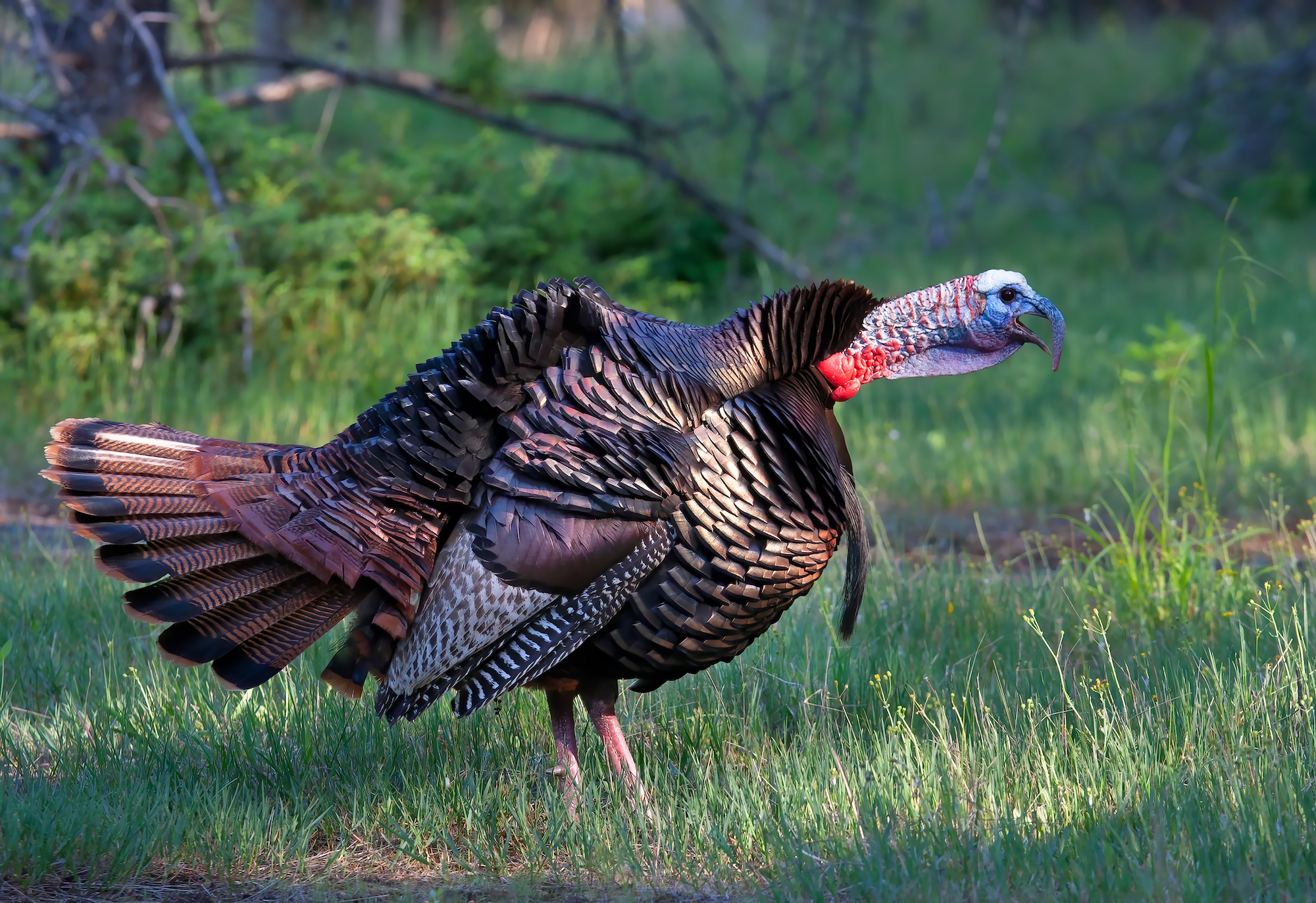Wild turkeys have incredible eyesight. Their ability to sense a predator, like a hunter leaning back against a tree, is uncanny. Turkey vision can seem even supernatural at times. But really, it’s just a combination of evolution and physiology. There’s still plenty we don’t know about how turkeys see, but researchers have uncovered plenty of interesting facts, many of which can be useful to hunters.
We know that a turkey’s vision is three times sharper than our own. They can also see nearly eight times farther than we can, and their color vision is far more enhanced than ours. Turkey vision has evolved over the course of millions of years to help them spot predators, locate mates, and identify challengers. Understanding how turkeys see and perceive danger just might help improve your hunting setups this spring.
Turkeys Can See in All Directions at Once
When it comes to keeping an eye out for predators, a wild turkey’s greatest asset is its ability to see in all directions at once. Turkeys have monocular vision, which means their eyeballs function independently of one another. (As opposed to our own binocular vision that uses both eyes in concert.) This gives the birds a 270-degree field of vision when their heads are perfectly still. But as most turkey hunters know, this is rarely the case.
“If you pay attention, [turkeys] turn their heads constantly. And because their eyes are working independently, that offers them a 360-degree field of view,” says Dr. Mike Chamberlain, a Distinguished Professor at the University of Georgia who’s been researching wild turkeys for the past 30 years. “Whereas you and I have peripheral vision, but we can’t see above or behind us, turkeys can. By changing their head posture constantly, it allows their eyes to pick up movement as two independent periscopes.”

Chamberlain says turkeys also rely on their keen sense of hearing to augment their vision. Working in combination, these two senses allow them to quickly and accurately pinpoint potential predators and other turkeys.
“Their hearing is the same in the sense that each ear registers the sound independently and transmits it to their brain. Coupled with their vision, they can hear something, look in that direction, and they can pinpoint exactly where that sound is coming from,” he explains. “That’s why they have that uncanny ability [to locate other birds]. You call at them from the tree, and ten minutes later they’re standing right there at the tree.”
The biggest trade-off for being able to see in all directions at once is that turkeys don’t have clear depth perception. The classic turkey head bob helps with this shortcoming, according to The Wild Turkey: Biology and Management, a book that was published in 1992 by the National Wild Turkey Federation and edited by Dr. James G. Dickson.
“Though the three dimensions of space cannot be clearly perceived,” Dickson writes, “the turkey can determine relative distances by a slight turning of its head and viewing an object at different angles.”
Turkeys Can See Color–Better Than Us
Of all the vertebrate species on the planet today, birds have the most complex retinas. Accordingly, they perceive a larger and richer spectrum of colors than humans and other mammals do.
Without getting too deep into eyeball science, the human retina has four types of photoreceptors, consisting of one rod and three single cones. Rods help us see in low light, while cones help convert light into color signals, allowing us to see short, moderate, and long wavelengths of blue, green, and red.
Read Next: What Colors Can Deer See?
A turkey’s retina, on the other hand, has seven different types of photoreceptors: one rod, four single cones, and two double cones. This allows turkeys (and other birds) to see a spectrum of colors that are imperceptible to the naked human eye.
Dr. Chamberlain tells Outdoor Life that there’s some debate among the scientific community about whether or not turkeys can see in the UV spectrum. Regardless, he says, their color vision is “extremely acute.” This gives the birds another advantage when scanning their surroundings for predators.
“They can just pinpoint colors so well,” Chamberlain says. “Blues, blacks, and other things in their environment that may not look natural, they can pick these out immediately.”
The importance of color goes beyond predator detection, however. Hen turkeys use their enhanced color vision to seek out mates, as the fitter, more dominant toms are always more colorful than the others.

“If you’re a dominant male, you’re going to breed more than a subordinate tom,” Chamberlain explains. “They’re more fit and more aggressive. They have longer snoods, more colorful heads, and more iridescence [in their feathers].”
Turkeys also have the amazing ability to change their head color to communicate and express emotions, like when a strutting gobbler’s head transitions from bluish-white to a bright reddish color.
Turkeys Have a Third Eyelid
In the 1992 book, Dr. Dickson points out that in addition to their regular outer eyelids, wild turkeys have translucent inner eyelids. Sometimes referred to as a “third eyelid”, the scientific term for this clear inner lid is a “nictating membrane.” All bird species have nictating membranes. So do most reptiles, amphibians, fish, and some mammals (including cats and dogs).
The only time turkeys shut their outer eyelids, Dickson explains, is when they’re asleep. The rest of the time, they use their nictating membranes to clean their eyeballs and sweep away dust and other fine particles
“Close observation of 8 imprinted adult [turkeys] of both sexes by the first author showed a frequency of 78 to 92 closings per minute of this third eyelid,” Dickson wrote, referring to a study conducted in 1967.
In this sense, a turkey’s eyeballs are like a pair of self-cleaning optics. Just imagine how clear and crisp your set of binoculars would be if they were being wiped with an invisible microfiber cloth at least once every second.
Vulnerable After Dark
When it comes to vision, there’s only one advantage we have over turkeys, and that’s seeing in the dark. Compared to other species like whitetails and raccoons, our night vision is fair to awful, but it’s still better than a turkey’s.
Their inability to see well at night is part of the trade-off for having such acute vision during the daytime. “And that’s why they sleep in trees,” Chamberlain says.

Wild turkeys will generally roost well before sunset, and they won’t fly down from the tree until after first light. This is why it’s critical for turkey hunters to set up well before sunrise—ideally somewhere close to a known roosting area.
READ NEXT: How to Turkey Hunt
By the time the sun rises, however, a turkey’s visual security system is back on high alert and all bets are off. At that point, moving as stealthily as possible (or not at all) is the name of the game.
Camouflage Considerations
So, from a scientific standpoint, does wearing camouflage from head to toe really give turkey hunters an advantage? Chamberlain thinks it does. He was a turkey hunter long before he became one of the country’s top turkey biologists, and he covers himself in camo for his own hunts.
“I’m that guy who wears a facemask so that you can’t see anything but his eyes,” he explains. “I’m on the side of trying to blend in as naturally as I can into whatever environment I’m hunting in.”
Read Next: Best Camo for Turkey Hunting of 2023
Chamberlain also says that the angle of the bird’s approach is critical. If the bird approaches you from straight on, you’ll likely have cover behind you (like an old oak tree). As long as you don’t move, you’ll remain undetected. (Remember, turkeys have a hard time with depth perception.) But if a bird approaches you from, say, behind your left shoulder as you sit against a tree, there will be no cover to break up your profile. That turkey will likely bust you.
“I just really don’t want that bird to see me move,” Chamberlain says. “As soon as you let that happen, you’re hosed.”

















